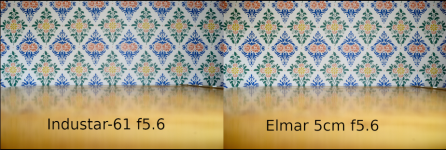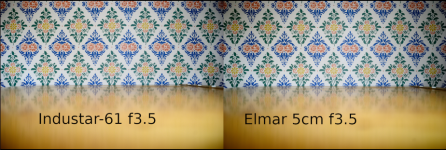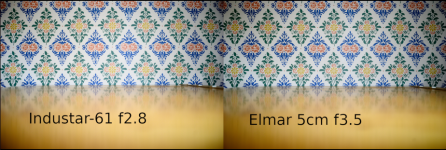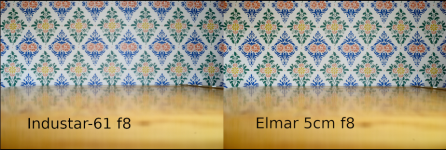@essbe, I've spent a lot of time thinking about this over the years - admittedly not as much or to anything like the technical depth of Brian - but here's what I found/figured out.
First, most of the (early) talk about FSU lenses on the internet complained of sample variation, and blamed the problem on shoddy workmanship. That's never sat well with me. After all, most of these lenses have been tinkered with or even outright butchered over the years. There is definitely some optical variation, as explained by Brian above, but it's still impossible to make claims like "Soviet lenses work fine on my Leica" without explanation or investigation because you don't have any clue what might have been done to the lenses you own or use throughout their lifespan.
So, looking at the historical and technical information available, it seems pretty clear that what's happened is that the Soviets used the same designs, tooling, and specs as they were using for the Kievs - in other words, the Zeiss material they took after the war - and applied that to make lenses for the "Soviet Thread Mount" camera families that had got their start with non-standardised lenses before the war.
If I'm understanding everything correctly, what that means is that the resulting cameras (and lenses) use the Contax standard for translating lens movement to the rangefinder, and that's where that 52.4mm figure comes from. It's not necessarily the real focal length of the "50mm" lenses, but that's what the rangefinder is expecting, so whether you're using a 35mm, "50mm", or 85mm lens, the rangefinder has to translate the travel of the lens' focusing helical and rangefinder cam to that 52.4mm standard - and as the Leica and all other LTM cameras use a 51.6mm standard, the discrepancy between the two always results in focusing errors unless the lens is adjusted in a way that negates it.
In real terms, that translates to Soviet lenses (of all designs and focal lengths) back-focusing a consistent amount on Leica, and Leica lenses front-focusing on a Soviet camera - unless those adjustments have been made to the lens at some point, of course.
The first method I used to try to show this was by doing a tightly controlled test with a Leica fixed on a tripod at 1m from a range of Soviet bodies, as shown below. As I only had a Canoscan at the time (which doesn't produce scans to any level of detail or sharpness), I then wet-printed from the resulting negatives to ensure I got the best possible representation of the images. Here's the image I put together from those prints:
 Soviet Lens Tests, Redux.
Soviet Lens Tests, Redux. by
Tony Gale, on Flickr
The lenses used were a collapsible Summicron, a black Jupiter 8 from 1976, a 1960's Industar 26m, and an unusual collapsible Industar 22 from the KOMZ factory (most were made in KMZ) - I tried to pick a spread of lenses that not only represented different production eras and lens designs, but also ones that I could guarantee hadn't been tampered with and that had all been purchased from different places. On top of that, I'd used all of them to produce great and perfectly focused photos on FED and Zorki bodies over the years. I forget what aperture I used, but considering the inclusion of the Industar 22 (an f/3.5 lens) and the similar depths of field, I think these were probably all at f/4 to standardise everything.
It should be pretty clear that all of the Soviet lenses not only backfocus, but backfocus
consistently - in other words, all by the same amount. And considering the way I picked these lenses out of the collection, there's no way this is down to sample variation or chance. I'm 99.9% certain that all unmolested Soviet lenses will behave this way.
Since then, I've worked out a faster and more easily demonstrable test - something you can do at home. If you set up a close-focus test using a vertical object with a flat plane and strong contrast - I have an old cultural theory book that's perfect for this - and measure 1m from the object (i.e. the front cover of said book) to a Leica's film plane, you should be able to focus a Leica lens and get the RF and focusing ring to match, confirming a perfect 1m; you might have to move the tripod laterally slightly to get everything to line up right. Once it does, you're set, and you've got your control. Now change the lens for a Soviet one (without moving the Leica, obviously), and try focusing with the RF; when the images in the RF align, look at the focusing ring, and it'll be at roughly 1.1m, suggesting a back focus of approximately 10cm. Replace the Leica with a FED or Zorki and a Leica lens, and you won't even be able to get the RF to line up with most LTM lenses; my Elmar 50/3.5 hits the close-focus stop on a FED 5 before the images align, and a 28mm Voigtlander Color-Skopar lands at 0.9m when focusing with the rangefinder at a 1m distance, indicating a front focus which nicely mirrors the 10cm measurement on the STM-on-Leica test.
To me, this definitively proves there's a systemic incompatibility here, regardless of how much some people continue to suggest otherwise.
Now, the final question is "does this matter?" For me, yes. I'm very hyper-aware of missed focus in photos - it drives me insane - and the fact that the Soviet 50mm lenses are still exhibiting severe back focus at f/4 at their closest focus on a Leica makes them basically unusable for me. I've even spotted it in my photos with a Jupiter 12 on a Leica, so that stays firmly on a FED now. However, if you never shoot anything close up, or are used to shooting with zone focusing (which should work fine) and never touch the rangefinder, knock yourself out - you probably won't have a problem with Soviet lenses on a Leica.
But personally, I'm treating both "STM" and LTM as the two totally different systems they seem to be, and never mix-and-match between the two.














